Her pictorial experiences have led her to use different supports for human bodies, from conventional canvas to tree trunks. Voluminous painting drew her to fill vast spaces. Her exterior installations of large strips of colours stretched between trees look like large licks of paint piercing the air and suggest that the spectator should question the nature of vegetation itself, its role and its current condition in the eyes of our society.
Her approach to volume, drove her to use a forge when working on copper, moving her away from the traditional technique of engraving. From the fire to the anvil, she inscribes on the metal: prints, folds and lines, and as a result of this trajectory, there are embosses and marks when it comes out of the forging machine.
She is also fond of the monotype method which, because it is quick to make, enables her to produce a series of rhythmic images that she sometimes enhances with gouache.
Arlette Vaistij masterly demonstrates the art of transforming former containers in to new contents, by using a rigorous technique which results in surprising and refreshing plastic images.
She parsimoniously distils these tins of white iron again and presents us, like snapshots, with these ephemeral images, which invite us to look at them in a new way.
In these new prints, she brings us colour, as an extension of her oxidized embosses and a series of black and white prints, with mastered chromatic fantasies, all produced with finesse and talent.
The paintings and drawings which Arlette Vaistij presents us with today are an invitation to travel through the meanders of the feminine universe.
Daughters of Venus or Aphrodite, Hathor, Ishtar or Inanna, these lady-flowers entice us to follow them and even to chase after them in these secret mazes that they personify with their presence, to fool around, play and frolic with them.
They symbolize love and fertility, they are the essence of them and they rouse the senses…”
Pierre Jaggi
IN ENGLISH
“Different techniques can be found in Arlette Vaistij’s work. Whether for paintings or engravings, she has always been interested in experimenting with new processes.
